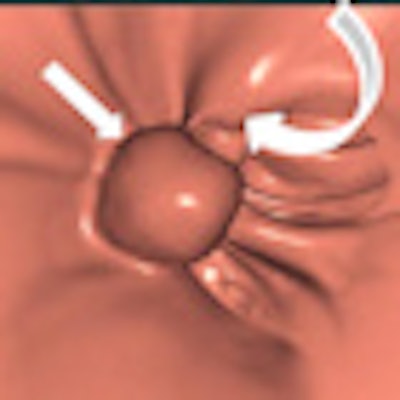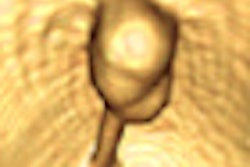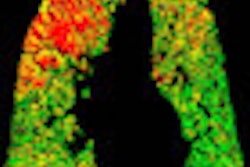
The European Society of Gastrointestinal and Abdominal Radiology (ESGAR) has published its first update on CT colonography (CTC) guidelines since 2007. Its working group on CTC has endorsed 86 statements, reaching near-complete agreement on 71 of the 86 items relating to critical practice areas affecting CTC.
Agreement was most consistent in the areas of colon distension, scan parameters, use of intravenous contrast agents, patient preparation, and the role of computer-aided detection (CAD) and lesion measurement. Less than unanimous accord was seen in the use of spasmolytics, decubitus positioning and the number of CT data acquisitions, fecal tagging, 2D versus 3D reading, and reporting.
"Over the last five years, expansion of the CT colonography literature has continued and several important studies, including multicenter studies, have been published," wrote Dr. Emanuele Neri and colleagues from six EU countries on behalf of the ESGAR CTC working group. "These new data have provided further insight regarding optimization of the CT colonography technique, interpretation, and diagnostic capabilities. Indeed CT colonography is now recommended for colorectal cancer screening by several international groupings and is widely used to investigate patients with symptoms suggestive of colorectal cancer," (European Radiology, 14 September 2012, online first).
The consensus statement was aimed at updating quality standards for CTC based on a literature review and the opinions of CTC experts on the ESGAR panel. The group members used a modified Delphi process to rate their level of agreement on several statements relating to the acquisition, interpretation, and implementation of CTC studies, which involved a survey conducted in several rounds. Following this process, the statements collected in the first round were distributed to the participants and modified for the second and third rounds, etc., to try to reach maximum agreement. Four Delphi rounds were conducted at two-month intervals.
A quality analysis of the results was performed using Cronbach's α correlation coefficient and SPSS (Chicago, IL), with Cronbach's α determined after each round of surveys, according to panel moderator Neri, who is an assistant professor of radiology at the University of Pisa, Italy. Technical performance of CTC garnered high agreement among the panelists, especially regarding colonic distension, CT parameters, use of intravenous contrast agents, and patient preparation, and there was full agreement on the role of CAD and lesion measurement.
"These data reflect a general homogeneity of approach between panel members despite their wide geographical spread," he noted.
Full consensus
The following are highlights of the statements on which full agreement was reached:
- Hyoscine N-butylbromide is the spasmolytic agent of choice.
- Automated CO2 distention is the colonic insufflation method of choice. The optimal amount of CO2 differs between subjects and should be judged considering colonic pressure.
- Prone and supine positioning are required for all CTC studies. A lateral decubitus scan is recommended if patients are unable to lie prone.
- Maximum collimation should be no greater than 2.5 mm and reconstructions should include a 20% to 30% overlap, with low-dose protocols used for screening. Fifty mAs is the preferred setting for prone and supine scans except in overweight patients. Dose modulation and iterative reconstruction techniques should be used when available. Low-dose exams (≤ 5.7 mSv) should be used for screening purposes.
- Scans should be performed in a craniocaudal direction to minimize breathing artifacts.
- IV contrast is not required except in patients with known colorectal cancer; however, it improves detection of extracolonic abnormalities.
- Exam quality should be assessed before the patient leaves the exam table.
- In patients who have recently undergone polypectomy, there is a case for delaying CTC.
- Dietary restrictions (for example, low-fiber diet) should be included in the colon cleansing regimen, and generally practitioners should weigh the tradeoff between the patient burden of a laxative regimen and the image quality required for the patient. Some frail and elderly patients may undergo CTC without laxative but with fecal tagging.
- Fecal tagging is mandatory, achieved with iodine, barium, or both agents.
- Either 2D or 3D is acceptable for the initial read, but all exams should include both, and in general 2D interpretation is likely to be faster, the authors wrote.
- Second-read computer-aided detection is recommended because it increases sensitivity without an unacceptable drop in specificity.
- CTC is less sensitive for flat lesions, whose definition is variable and controversial at present. With flat lesions, report lesion height above the colonic mucosa.
- Lesion diameter may be measured in 2D or 3D, but 3D is more likely to be inaccurate. There is frequent disagreement between CTC and endoscopic measurements.
- CTC should be reported only by a radiologist trained in the technique.
Less than full consensus
The performance of a digital rectal exam was standard practice in some centers before insertion of the rectal tube, and achieved a recommended score of 4.56 out of a possible five points, the authors wrote. Practices also differed with regard to the use of IV spasmolytic agents, with many centers administering them to all patients while others used them only in selected individuals. Thus, the use of spasmolytic agents was recommended by the majority but not considered mandatory.
"The differences in CT protocols included the need for additional CT data acquisition and insufflation in cases of poor colonic distension; a minority of experts did not consider this mandatory although they agreed it should be recommended," Neri et al wrote. "An additional decubitus acquisition was recommended, if required, to improve the diagnostic quality of the examination."
Accurate polyp measurement is problematic for both CTC and conventional colonoscopy, the authors wrote. The group concluded that the maximal diameter of lesions should be estimated using axial and multiplanar reformatted 2D views, considered the most reliable, avoiding a narrow CT window. Caution should be used with 3D measurements, which may be prone to distortion, they added.
"In summary, the panel covered all important aspects regarding the practice of CTC and reached full agreement on most statements," the group wrote. "The consensus has been structured to give clear guidelines for the practice of CT colonography."
The recommendations are useful for radiologists wishing to start a practice, and for practicing CTC providers looking to update their techniques, they concluded.
Neri's colleagues on the ESGAR CTC working group were Dr. Steve Halligan from University College London; Dr. Mikael Hellström from the University of Gothenburg in Sweden; Dr. Philippe Lefere from Virtual Colonoscopy Teaching Center in Hooglede, Belgium; Dr. Thomas Mang from the Medical University of Austria in Vienna; Dr. Daniele Regge from the Institute for Cancer Research and Treatment, Candiolo-Torino, Italy; Dr. Jaap Stoker from the University of Amsterdam; Dr. Stuart Taylor from University College London; and Dr. Andrea Laghi from the University of Rome.



















